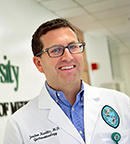A year-by-year age analysis of colorectal cancer rates among adults in the United States has found a 46% increase in new diagnoses from ages 49 to 50, indicating that many latent cases of the disease are likely going undiagnosed until routine screenings begin at 50, according to a new study by Abualkhair et al in JAMA Network Open. Researchers found that almost 93% of the cases discovered at age 50 were invasive.

Jordan Karlitz, MD
“Our findings suggest a high case burden of preclinical, undetected early-onset colorectal cancers in patients younger than 50 that is not reflected in observed incidence rates,” said lead study author Jordan Karlitz, MD, Associate Clinical Professor of Medicine at Tulane University School of Medicine and staff gastroenterologist at the Southeast Louisiana Veterans Health Care System.
Age for Screening
In 2018, the American Cancer Society called for routine screenings for colorectal cancer to begin at age 45. However, the U.S. Preventive Services Task Force, which sets federal screening standards, currently recommends that average-risk screening begin at age 50. Those against beginning screenings at age 45 have argued that incidence rates in those aged 45 to 49 have been considered relatively low compared to those aged 50 to 54.
Study Methods
Authors of the current study suspected the risks for those in their mid-to-late 40s are underestimated because incident data for those age ranges would likely only include cases diagnosed in patients because they presented symptoms and/or have a family history of cancer, in contrast to those 50 and older, who have cancers also detected due to screening.
To assess this, researchers examined colorectal cancer incidence rates in 1-year increments in patients between the ages of 30 to 60 from the year 2000 to 2015. They suspected that if there were many asymptomatic cases of the disease undetected, there would be a marked increase in cases between ages 49 and 50, when screenings begin.
KEY POINTS
- Researchers found an increase from 34.9 diagnoses per 100,000 people at age 49, to 51 cases per 100,000 at age 50.
- Increases were also seen in both men (52.9%) and women (39.1%), in white (46.2%) and black (47.3%) populations, and in colon (51.4%) and rectal (37.6%) cancers in this 1-year age transition.
- Researchers also examined the stage at which the cancers were diagnosed and found an uptick in localized and regional cancers in the 1-year increment.
Analysis Results
Researchers found an increase from 34.9 diagnoses per 100,000 people at age 49, to 51 cases per 100,000 at age 50. Increases were also seen in both men (52.9%) and women (39.1%), in white (46.2%) and black (47.3%) populations, and in colon (51.4%) and rectal (37.6%) cancers in this 1-year age transition. These incidence increases from age 49 to 50 were not seen in prior studies because only age group ranges were analyzed. Researchers also examined the stage at which the cancers were diagnosed and found an uptick in localized and regional cancers in the 1-year increment.
Dr. Karlitz commented that the combined burden of undetected and detected early-onset colorectal cancer cases for those aged 45 to 49 may actually approach that of individuals in their early 50s.
“Our data support that the incidence of colorectal cancer increases substantially among individuals in their early 50s compared with individuals in their late 40s, not because rates are truly lower among those aged 45 to 49 years, but because colorectal cancers are present but undetected until diagnosed when screening is ultimately initiated,” he explained.
A limitation of the study is its population-based design, which limited researchers’ ability to determine exactly which patients had cancers detected at age 50 through screening vs diagnostic testing. “Nevertheless, the significantly high rate of invasive cases supports that almost all cancers accounted for in the rate increase from age 49 to 50 required aggressive treatment, regardless of how they were detected,” concluded Dr. Karlitz.
Disclosure: For full disclosures of the study authors, visit jamanetwork.com.

